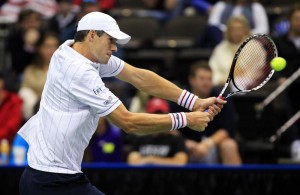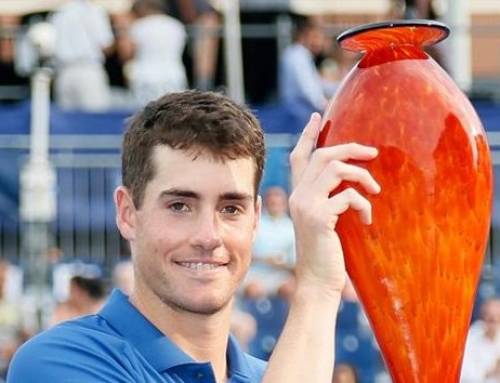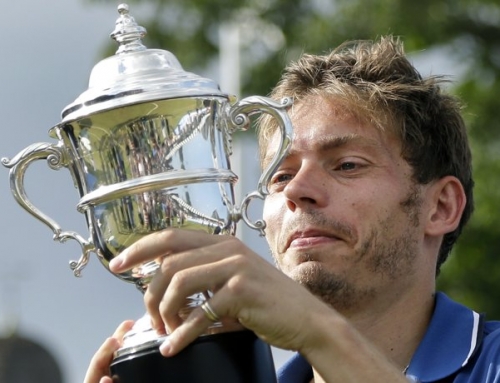 There are three tournaments being played now. Two are ATP 500 events and one is an ATP 250. The ATP 500 events are Dubai and Acapulco. Four of the top 5 players in the world are playing in those tournaments. Djokovic and Federer played in Dubai. Nadal and Ferrer are playing in Acapulco.
There are three tournaments being played now. Two are ATP 500 events and one is an ATP 250. The ATP 500 events are Dubai and Acapulco. Four of the top 5 players in the world are playing in those tournaments. Djokovic and Federer played in Dubai. Nadal and Ferrer are playing in Acapulco.
This leaves Delray Beach with the leftovers. With Americans not dominating the tour, many have headed to Florida for this ATP 250 event. When you have an event that doesn’t have any top 10 players, then upsets are the order of the day, and that held true here.
In the first semi, Tommy Haas, who was in the San Jose final, was trying to upset Ernests Gulbus. Both players have actually won at Delray Beach before. Haas won in back in 2006 while Gulbis won in 2010.
Gulbis was expected to be a very good player based on his performances back in 2007 and 2008. In 2007, Gulbis reached the fourth round of the US Open. In 2008, he reached the quarterfinals of the French Open. 2010 was a decent year for Gulbis. He upset Federer on clay and took a set off of Nadal which was an accomplishment that year when Nadal went on a tear during the clay season.
Since then, however, his play has been rather poor, and his rank has plummeted into triple digits. He has changed his forehand to something exotic like a traffic guard directing traffic, Gulbis uses his left arm up high as if he’s asking oncoming traffic to stop, then hits a new peculiar forehand. The forehand has decent spin, but he can be erratic, spraying balls. It was quite the contrast to watch Haas-Gulbis compared to the much cleaner Djokovic-Berdych match.
Delray Beach was very windy this afternoon, and this lead to players playing conservatively, many shots up the middle, lest they hit the balls wide. Gulbis was able to take the lead with an opening 63 set, but Haas started preying on Gulbis errors and took the second set 64. The third set looked like it might go Haas way. He certainly had plenty of break point chances, but Gulbis kept digging himself out of holes, and avoided going down the break. By the time the third set tiebreak was played, Gulbis got to an early lead and kept ahead the entire way winning 7-2.
The other semis pitted John Isner and Edouard Roger-Vasselin. Like Gulbis, Roger-Vasselin is ranked in the low 100s. Unlike Gulbis, the Frenchman has never reached a semifinal on the pro tour. Roger-Vasselin’s father was also a tennis player and once reached the French Open semis.
Roger-Vasselin is another of the many older players that are playing better as they get older. Although Isner was the top seed, Roger-Vasselin had so many things in his game that gave Isner trouble. In particular, he returned a lot of Isner’s serves. By returning so many serves, Roger-Vasselin kept the match in his favor because he’s a crisp hitter of the ball, able to aim for lines. He doesn’t have huge power, but he hits hard enough and accurate enough to make Isner run.
Meanwhile, Isner resorted to his usual strategies, that is, to hit big with his forehand and come to net when he could. Roger-Vasselin makes good passes. It didn’t help that Isner kept missing volleys at net, usually dumping the forehand volley.
Roger-Vasselin had an early break in the first set and took it 6-4. He also had an early break in the second set, and threatened to go to double break, but Isner kept hanging on. Then, nerves came and Roger-Vasselin double faulted and gave the break back, then another break to let Isner take the second set, 6-4. Roger-Vasselin hung tough and took another early break in the third set. This time, he was able to keep that break lead. Isner, by contrast, struggled nearly every game to hold serve, and avoid going down a second break. Finally, Roger-Vasselin served out the set quite easily.
Roger-Vasselin and Gulbis will face each other in the finals, in the battle of two players ranked in the low 100s.



![[Stockholm] Dimitrov wins first ATP title with 3-set victory over Ferrer](https://www.essentialtennis.com/wp-content/uploads/2013/10/20131021grigor-500x383.jpg)
![[Metz/St. Petersburg] Simon and Gulbis are champions!](https://www.essentialtennis.com/wp-content/uploads/2013/09/20130922gulbis-500x383.jpg)

